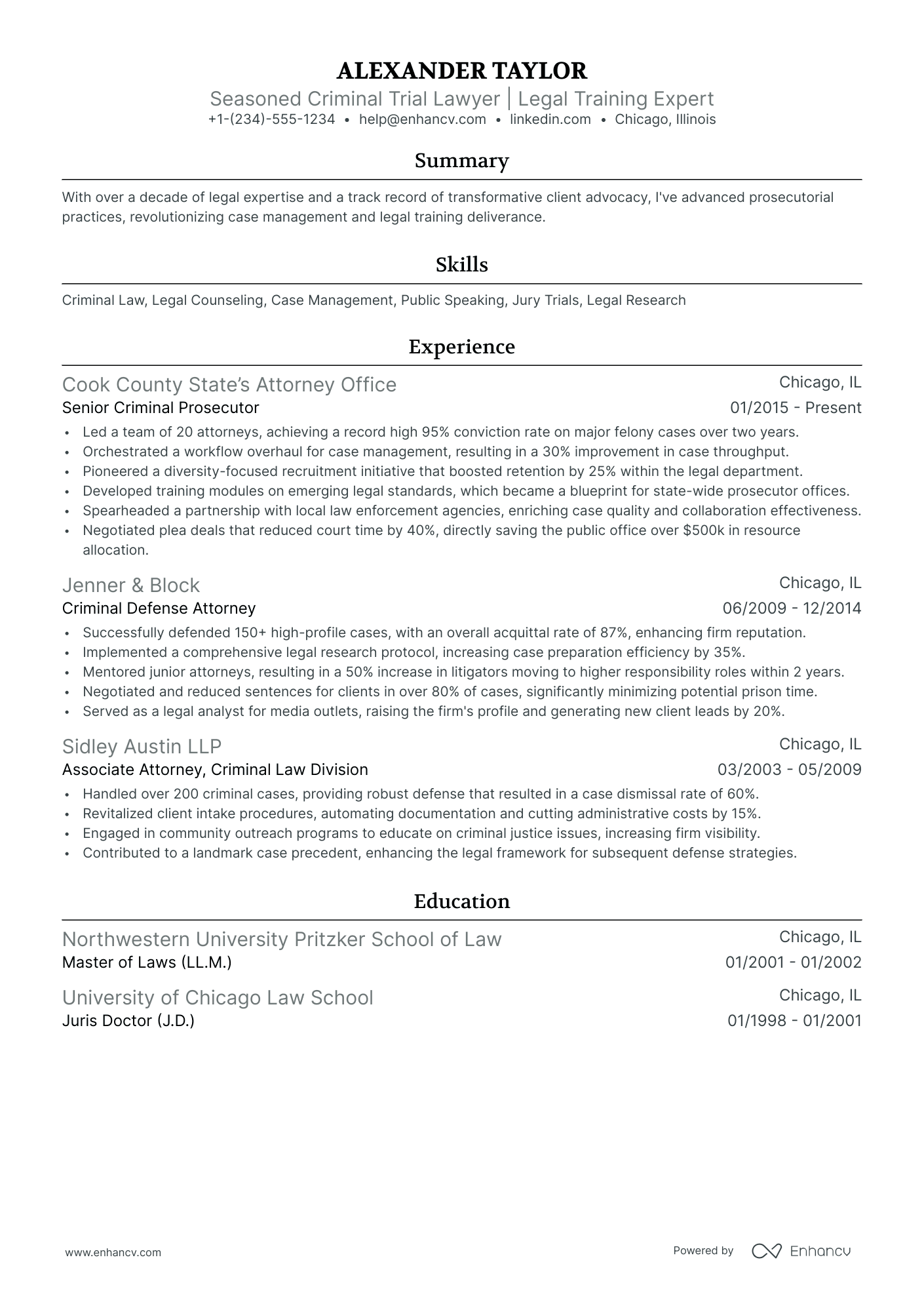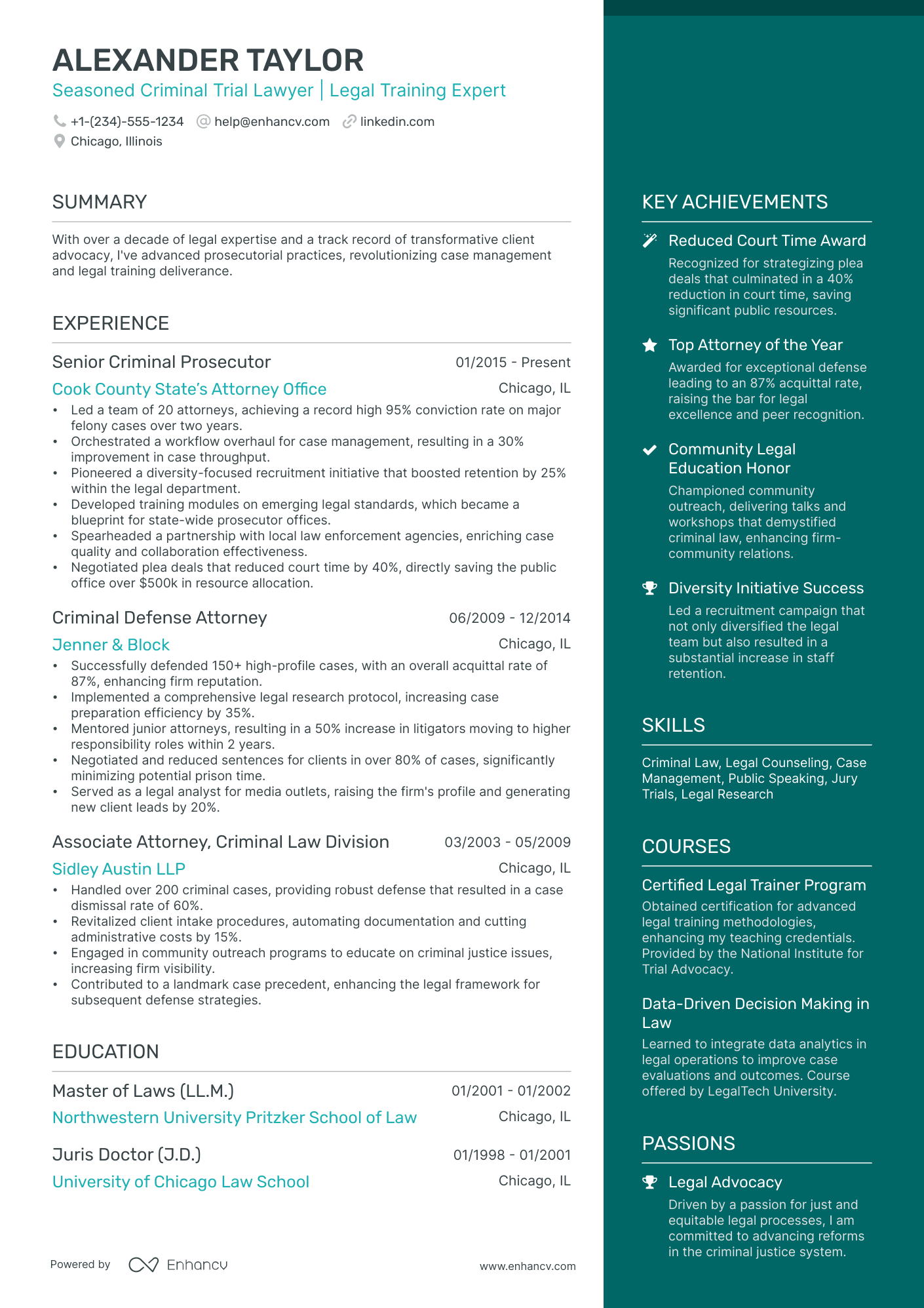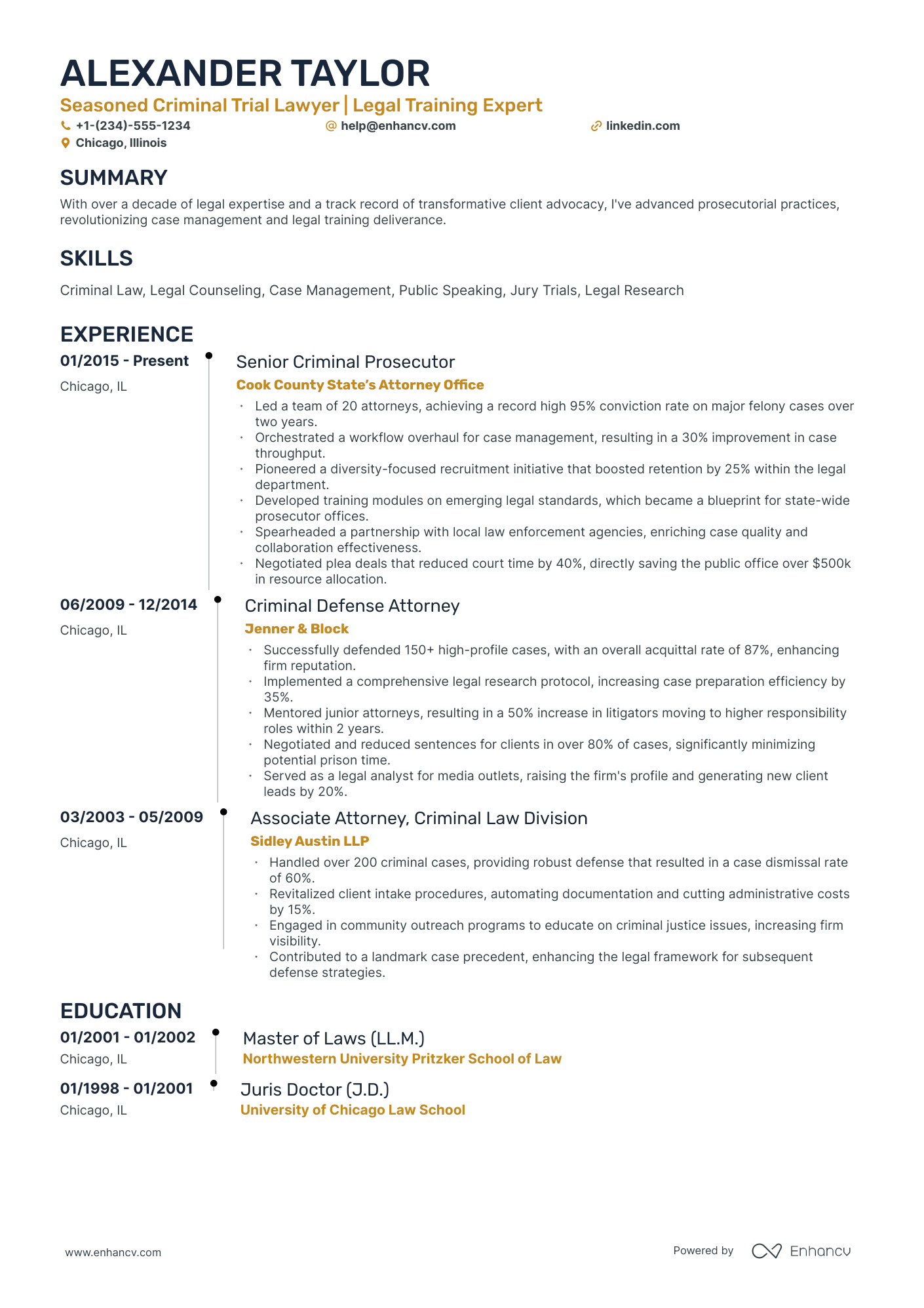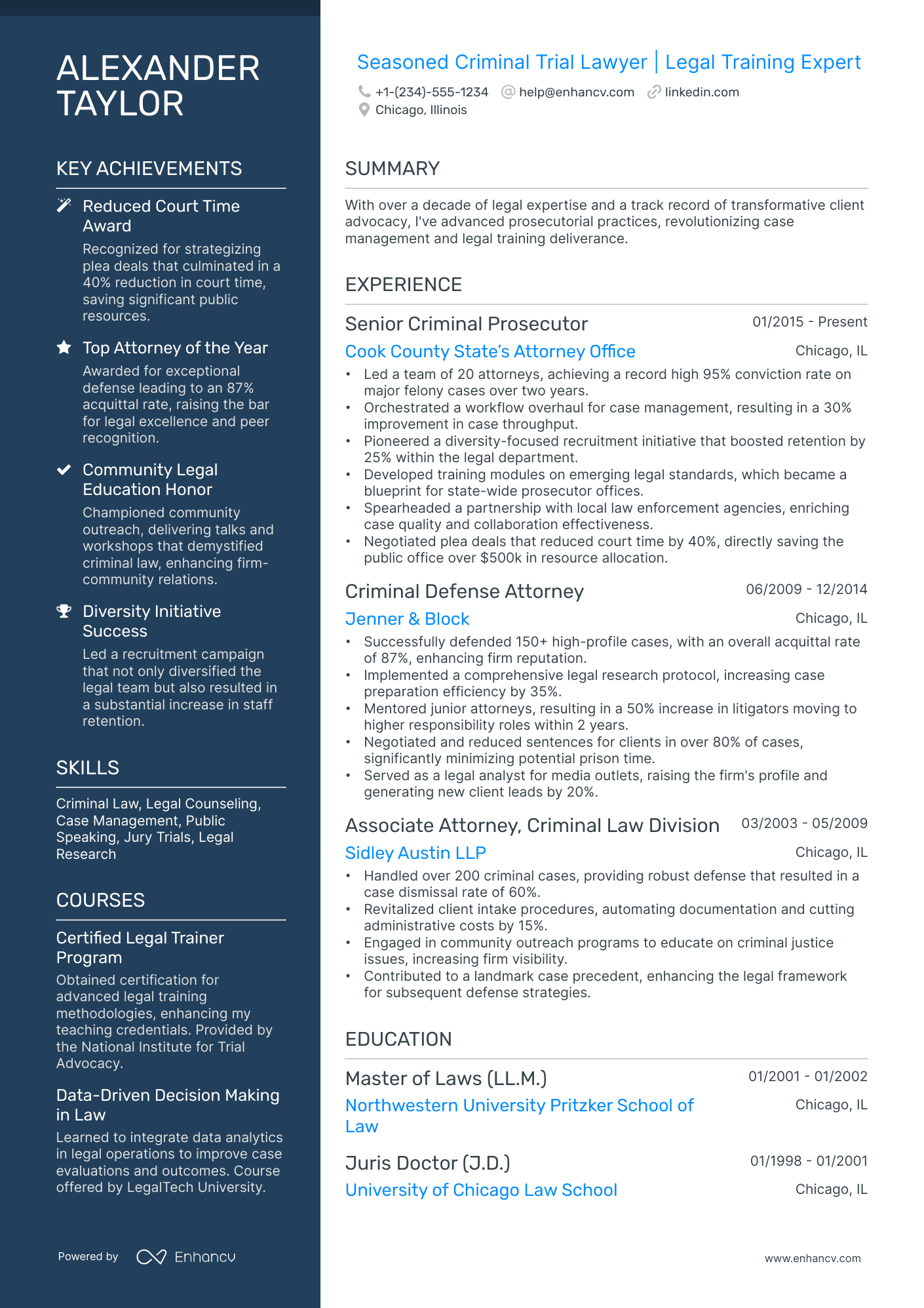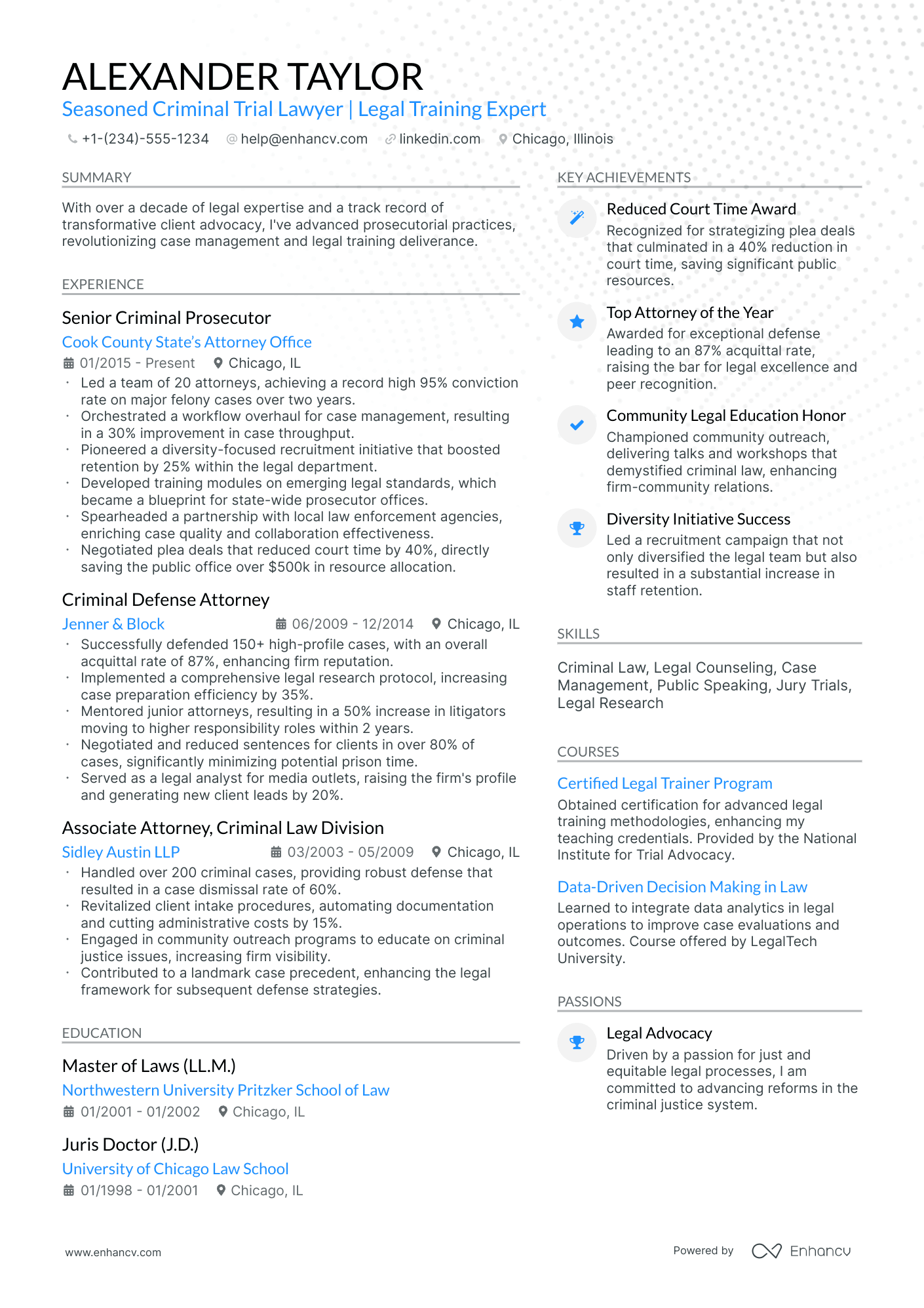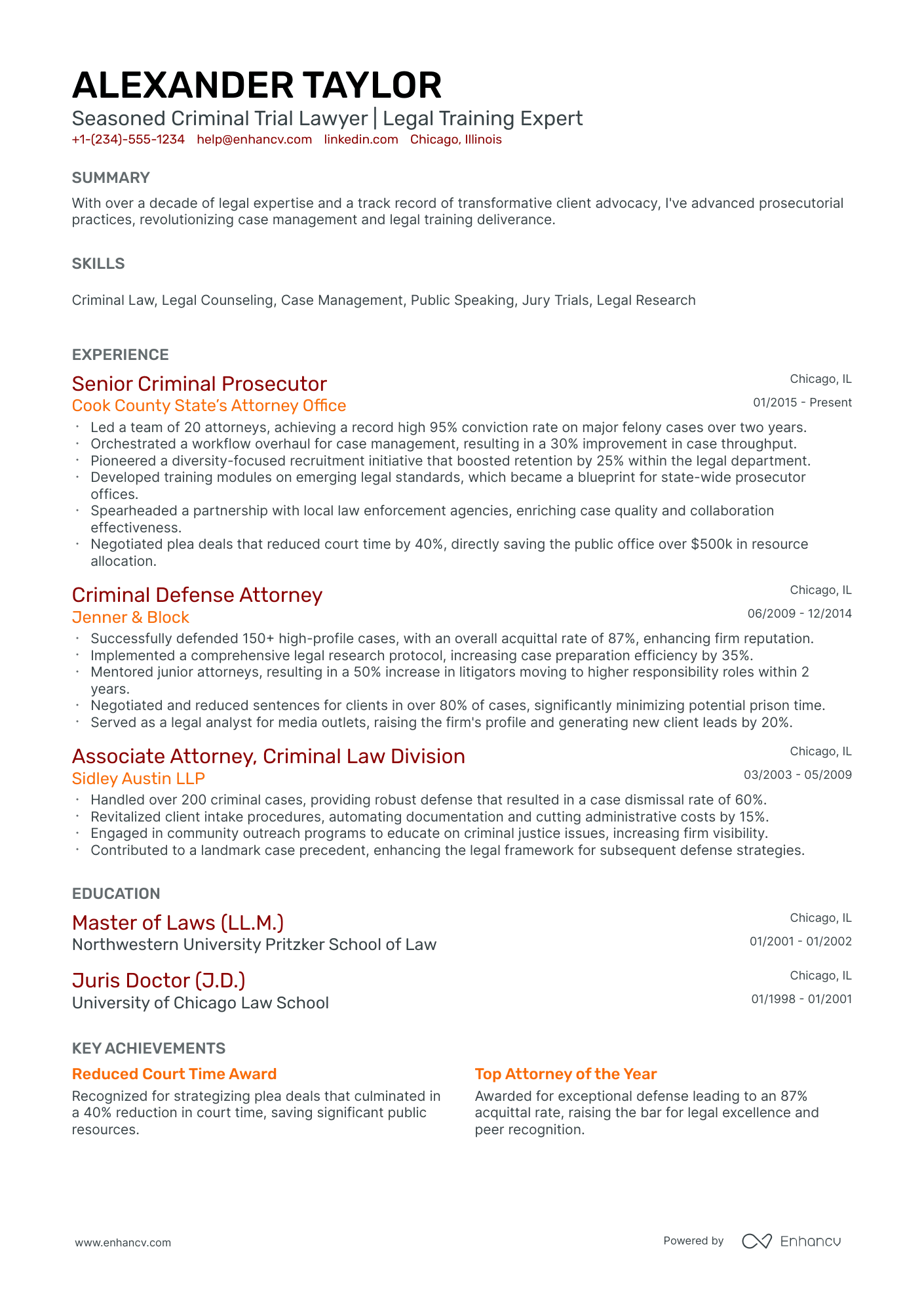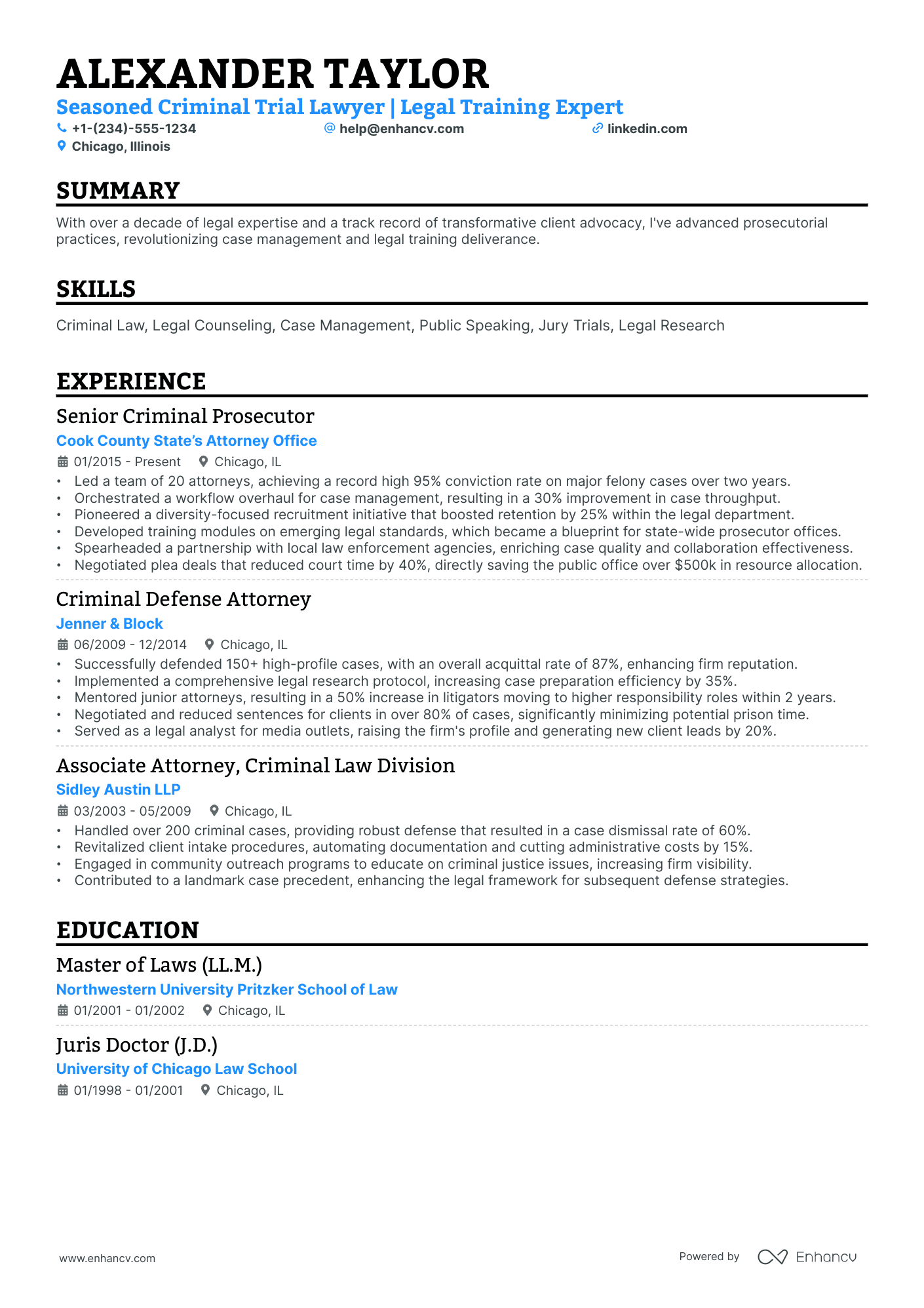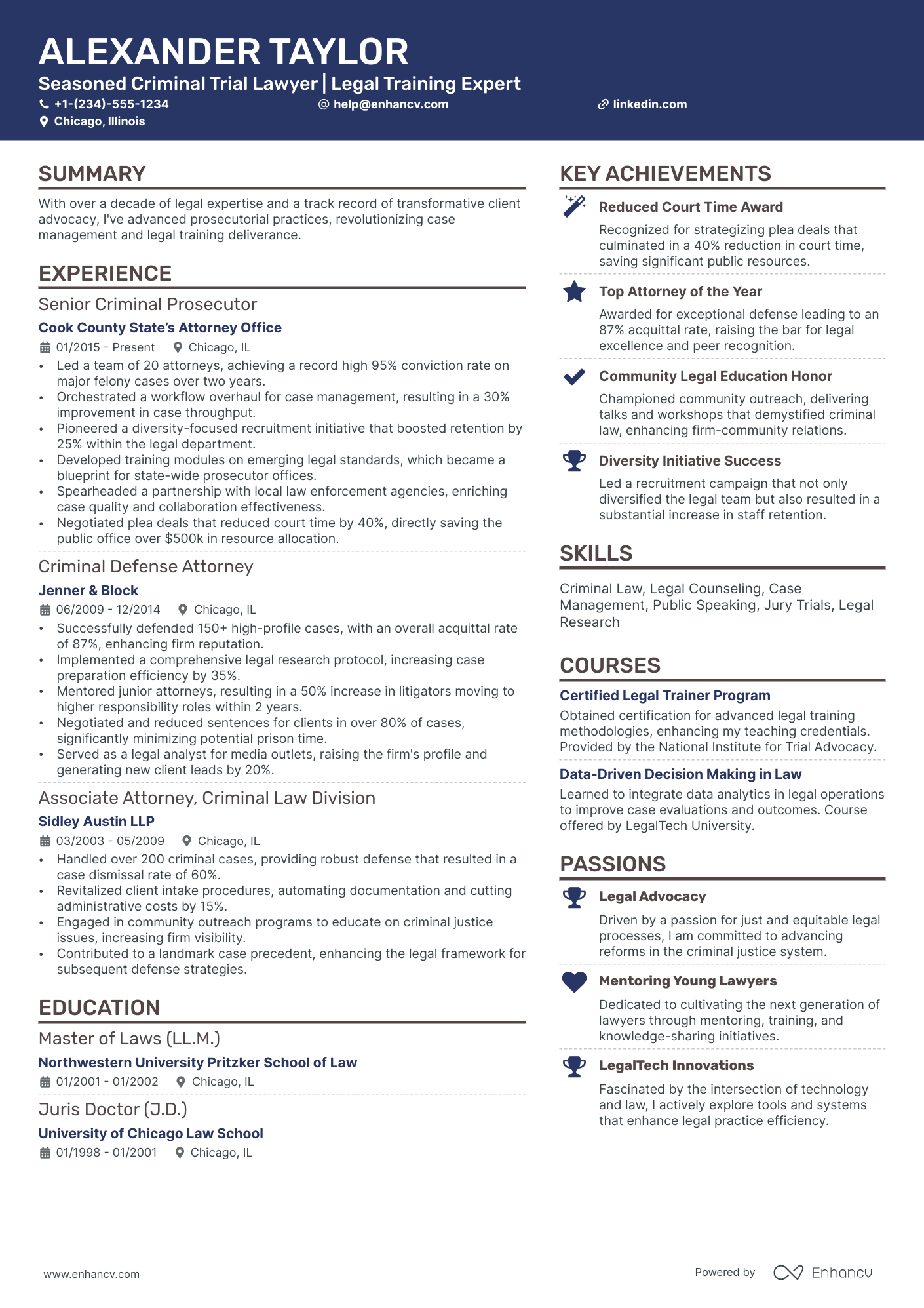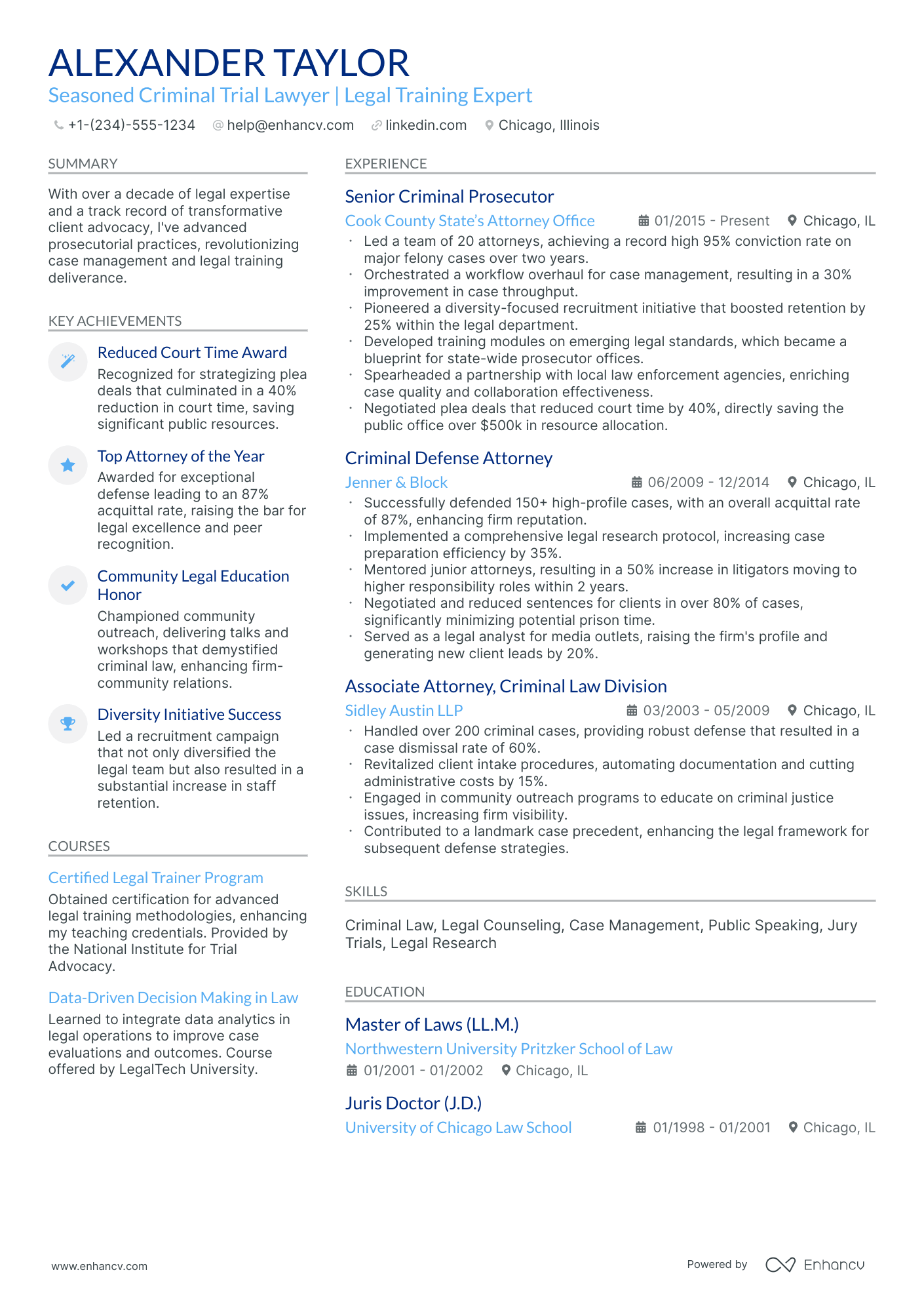As a trial lawyer, one specific resume challenge you may encounter is demonstrating your ability to handle complex litigation while still showing a personal touch that resonates with clients and firms. Our guide will provide actionable strategies to showcase both your legal prowess and client relations skills, helping your resume stand out in a competitive field.
- Utilize real-life examples to refine your trial lawyer resume;
- Effectively write the experience section of your trial lawyer resume, even if you have minimal or no professional experience;
- Incorporate the industry's top 10 essential skills throughout your resume;
- Include your education and certifications to highlight your specific expertise.
If the trial lawyer resume isn't the right one for you, take a look at other related guides we have:
Don't stress out over your trial lawyer resume format
Remember, the elaborate design of your trial lawyer resume isn't what impresses recruiters most. They are primarily searching for candidates who meet the job requirements. The main aim of your resume should be to clearly and concisely explain why employers should hire you.
Here are four straightforward steps to consider in your trial lawyer resume design:
- Organize your resume based on experience: Start with your most recent roles. Besides using reverse chronological order, choose jobs relevant to the position you're applying for.
- Include your contact details (and portfolio or LinkedIn link) in your resume's header to ensure recruiters can easily reach you. If considering adding a professional photo, check acceptable practices in different countries first.
- Don't omit essential trial lawyer resume sections such as the summary or objective, experience, and education. These sections should reflect your career progression and align with job requirements.
- Maintain conciseness in your resume. For those with less than ten years of experience, a one-page format is advisable.
Regarding the format to submit your trial lawyer resume, PDF is preferable. PDFs are more likely to maintain their formatting when processed through recruitment software or ATS, saving you time in the application process.
When selecting a font for your trial lawyer resume, consider the following:
- Choose ATS-friendly fonts such as Exo 2, Volkhov, Lato, etc., to keep your resume's content legible;
- All serif and sans-serif fonts are easily readable by ATS;
- While Arial and Times New Roman are common choices, opting for unique typography can help your resume stand out.
Concerned about ATS compatibility with charts and infographics? Our recent study has debunked this and other myths.
Tailor your resume format to the job market – a Canadian resume, for example, might differ in layout.
Upload & Check Your Resume
Drop your resume here or choose a file. PDF & DOCX only. Max 2MB file size.
PRO TIP
Always remember that your trial lawyer certifications can be quantified across different resume sections, like your experience, summary, or objective. For example, you could include concise details within the expertise bullets of how the specific certificate has improved your on-the-job performance.
Traditional sections, appreciated by recruiters, for your trial lawyer resume:
- Clear and concise header with relevant links and contact details
- Summary or objective with precise snapshot of our career highlights and why you're a suitable candidate for the trial lawyer role
- Experience that goes into the nuts and bolts of your professional qualifications and success
- Skills section(-s) for more in-depth talent-alignment between job keywords and your own profile
- Education and certifications sections to further show your commitment for growth in the specific niche
What recruiters want to see on your resume:
- Case Litigation Success: Demonstrating a track record of successful trial outcomes, including significant verdicts or settlements.
- Courtroom Proficiency: Experience in courtroom procedure, jury selection, and delivering compelling opening and closing arguments.
- Legal Research & Writing Skills: Showcasing proficiency in drafting motions, briefs, and other important legal documents with precision and persuasiveness.
- Client Representation & Advocacy: Detailing experience in representing clients in various cases and the ability to advocate zealously on their behalf.
- Continuing Legal Education: Participation in advanced trial advocacy programs or certifications that show a commitment to honing trial skills and legal knowledge.
What to include in the experience section of your trial lawyer resume
The resume experience section is perhaps the most important element in your application as it needs to showcase how your current profile matches the job.
While it may take some time to perfect your trial lawyer experience section, here are five tips to keep in mind when writing yours:
- Assess the advert to make a list of key requirements and look back on how each of your past jobs answers those;
- Don't just showcase you know a particular skill, instead, you need proof in the form of tangible results (e.g. numbers, percent, etc.);
- It's perfectly fine to leave off experience items that don't bring anything extra to your skill set or application;
- Recruiters want to understand what the particular value is of working with you, so instead of solely featuring technologies, think about including at least one bullet that's focused on your soft skills;
- Take care with wording each bullet to demonstrate what you've achieved, using a particular skill, and an action verb.
The below trial lawyer resume examples can help guide you to curate your professional experience, following industry-leading tips and advice.
- Successfully conducted over 40 jury trials with a focus on complex civil litigation, achieving a favorable verdict in 75% of cases.
- Implemented innovative technology for trial presentations, leading to enhanced persuasive storytelling and a 30% increase in jury engagement.
- Served as lead counsel in high-profile intellectual property disputes, securing on average $2M in settlements or verdicts favorable to clients.
- Managed a caseload of 100+ clients, providing strategic legal counsel and maintaining a client satisfaction rate exceeding 90%.
- Orchestrated a defense strategy for a series of class-action lawsuits with an emphasis on corporate malfeasance, resulting in the dismissal of 80% of the claims.
- Enhanced firm's litigation protocols by implementing a rigorous evidence review process, reducing discovery times by 25%.
- Specialized in medical malpractice defense, successfully reducing clients' potential liabilities by 60% through aggressive pre-trial settlements.
- Directed a team of junior associates and paralegals, improving team productivity by 40% through mentorship and streamlined workflow solutions.
- Devised and conducted focused jury research, which directly influenced trial strategy and contributed to winning 90% of defense verdicts.
- Efficiently balanced workload of criminal defense cases and civil rights litigation, achieving a success rate of 80% in securing acquittals or reduced charges for clients.
- Spearheaded legal workshops for underserved communities that raised awareness of legal rights, benefitting over 500 individuals annually.
- Authored and argued numerous motions that have resulted in the suppression of evidence critical to the prosecution's case, swinging outcomes in favor of the defense.
- Played a pivotal role by leading the litigation team in a $50 million breach of contract case, securing a unanimous verdict for the client.
- Cultivated client relations and expanded the firm’s portfolio by 20% through diligent representation and networking within the business sector.
- Delivered expert witness preparation, significantly enhancing testimony effectiveness and contributing to positive trial outcomes.
- Instrumental in negotiating and mediating settlements in over 50% of assigned cases, leading to an impressive reduction of litigation costs by 35% for the firm.
- Pioneered the use of virtual reality in the courtroom to accurately reconstruct crime scenes, leading to a groundbreaking acquittal in a high-profile murder trial.
- Implemented continuous legal education strategies within the firm, elevating the practice’s profile and expertise especially in digital evidence handling.
- Directed the firm’s mass tort litigation department, overseeing cases with combined claims exceeding $200 million, and securing favorable outcomes in 85% of adjudicated matters.
- Fostered a dynamic team environment that prioritized client communication, resulting in a 50% reduction in client complaints about case handling.
- Lead complex negotiations with opposing counsel to disentangle multi-faceted legal issues, often arriving at creative settlements beneficial to all parties involved.
- Focused on the development and prosecution of securities fraud cases, with a record 90% of cases settled favorably before trial.
- Acted as liaison between the legal team and regulatory agencies, streamlining compliance processes and reducing potential sanction risks by 70%.
- Coordinated with international legal teams to manage cross-border disputes, aligning litigation strategies and mitigating risks associated with global operations.
The following content includes information from "O*NET OnLine" by the U.S. Department of Labor, Employment and Training Administration (USDOL/ETA). Used under the CC BY 4.0 license. The data represents the top responsibilities present on the task lists for trial lawyer professionals.
Top Responsibilities for Trial Lawyer:
- Interpret laws, rulings and regulations for individuals and businesses.
- Analyze the probable outcomes of cases, using knowledge of legal precedents.
- Gather evidence to formulate defense or to initiate legal actions by such means as interviewing clients and witnesses to ascertain the facts of a case.
- Represent clients in court or before government agencies.
- Evaluate findings and develop strategies and arguments in preparation for presentation of cases.
- Advise clients concerning business transactions, claim liability, advisability of prosecuting or defending lawsuits, or legal rights and obligations.
- Examine legal data to determine advisability of defending or prosecuting lawsuit.
- Prepare, draft, and review legal documents, such as wills, deeds, patent applications, mortgages, leases, and contracts.
- Study Constitution, statutes, decisions, regulations, and ordinances of quasi-judicial bodies to determine ramifications for cases.
- Negotiate settlements of civil disputes.
Quantifying impact on your resume
- Include the number of cases tried to verdict to demonstrate extensive experience in litigation.
- List the total amount of damages awarded in cases you've won to showcase your effectiveness in securing favorable outcomes for clients.
- Mention the percentage of cases settled favorably before trial to illustrate negotiation skills and efficiency in resolving disputes.
- Quantify the size of the class in class action lawsuits you've handled to indicate your capability to manage large and complex cases.
- Detail the number of published legal articles or case studies you have authored to display thought leadership and expertise in your field.
- State the number of successful appeals you have argued to highlight your proficiency in appellate advocacy.
- Specify the percentage growth of your practice or client base over time to show your contribution to business development.
- Present the number of hours contributed to pro bono work to reflect a commitment to social responsibility and community service.
Action verbs for your trial lawyer resume
Trial lawyer resume without experience: a walk-through guide
If you don't happen to have any relevant experience yet, you can substitute this with:
- Short-term gigs and stunts - like month-long internships, that you have done during your university days
- Contract work - be specific about the relevance and outcomes of each role you include
- Resume format that prioritizes your skills - the functional-skill-based format or hybrid format could work
- Research roles - feature those especially prominently if you've participated in a noteworthy project or your role was of utmost importance to the project's success.
Recommended reads:
PRO TIP
Bold the names of educational institutions and certifying bodies for emphasis.
The heart and soul of your trial lawyer resume: hard skills and soft skills
If you read between the lines of the trial lawyer role you're applying for, you'll discover that all requirements are linked with candidates' hard skills and soft skills.
What do those skills have to do with your application?
Hard or technical skills are the ones that hint at your aptitude with particular technologies. They are easy to quantify via your professional experience or various certifications.
Meanwhile, your soft skills are more difficult to assess as they are personality traits, you've gained thanks to working in different environments/teams/organizations.
Your trial lawyer resume skills section is the perfect opportunity to shine a light on both types of skills by:
- Dedicating a technical skills section to list up to six technologies you're apt at.
- Focusing a strengths section on your achievements, thanks to using particular people skills or technologies.
- Including a healthy balance of hard and soft skills in the skills section to answer key job requirements.
- Creating a language skills section with your proficiency level - to hint at an abundance of soft skills you've obtained, thanks to your dedication to learning a particular language.
Within the next section of this guide, stay tuned for some of the most trending hard skills and soft skills across the industry.
Top skills for your trial lawyer resume:
Legal Research Software
Case Management Software
Document Management Systems
E-discovery Tools
Trial Presentation Software
Legal Writing Tools
Billing and Accounting Software
Evidence Presentation Technology
Online Legal Databases
Remote Communication Tools
Negotiation
Public Speaking
Critical Thinking
Persuasion
Time Management
Emotional Intelligence
Analytical Skills
Attention to Detail
Interpersonal Skills
Problem Solving
Next, you will find information on the top technologies for trial lawyer professonals from "O*NET OnLine" by the U.S. Department of Labor, Employment and Training Administration (USDOL/ETA). Used under the CC BY 4.0 license.
Top technologies for Trial Lawyer’s resume:
- LexisNexis CaseMap
- Microsoft Access
- IDEA TrialPro
- Microsoft PowerPoint
- Adobe Acrobat
- Microsoft Office SharePoint Server MOSS
PRO TIP
If you failed to obtain one of the certificates, as listed in the requirements, but decide to include it on your resume, make sure to include a note somewhere that you have the "relevant training, but are planning to re-take the exams". Support this statement with the actual date you're planning to be re-examined. Always be honest on your resume.
Education section and most popular trial lawyer certifications for your resume
Your resume education section is crucial. It can indicate a range of skills and experiences pertinent to the position.
- Mention only post-secondary qualifications, noting the institution and duration.
- If you're still studying, highlight your anticipated graduation date.
- Omit qualifications not pertinent to the role or sector.
- If it provides a chance to emphasize your accomplishments, describe your educational background, especially in a research-intensive setting.
Recruiters value trial lawyer candidates who have invested their personal time into their professional growth. That's why you should include both your relevant education and certification . Not only will this help you stand out amongst candidates, but showcase your dedication to the field. On your trial lawyer resume, ensure you've:
- Curated degrees and certificates that are relevant to the role
- Shown the institution you've obtained them from - for credibility
- Include the start and end dates (or if your education/certification is pending) to potentially fill in your experience gaps
- If applicable, include a couple of job advert keywords (skills or technologies) as part of the certification or degree description
If you decide to list miscellaneous certificates (that are irrelevant to the role), do so closer to the bottom of your resume. In that way, they'd come across as part of your personal interests, instead of experience. The team at Enhancv has created for you a list of the most popular trial lawyer certificates - to help you update your resume quicker:
The top 5 certifications for your trial lawyer resume:
- Certified trial lawyer (CTL) - National Board of Trial Advocacy (NBTA)
- Board Certified Civil trial lawyer - American Board of Professional Liability Attorneys (ABPLA)
- Certified Criminal Trial Advocate (CCTA) - National Board of Legal Specialty Certification (NBLSC)
- Certified Family Law Trial Advocate (CFLTA) - National Board of Trial Advocacy (NBTA)
- Master Advocate Designation - National Institute for Trial Advocacy (NITA)
The content below includes information from "O*NET OnLine" by the U.S. Department of Labor, Employment and Training Administration (USDOL/ETA). Used under the CC BY 4.0 license. The data represents the top associations for trial lawyer professionals.
Top US associations for a Trial Lawyer professional
- American Association for Justice
- American Bar Association
- American Health Lawyers Association
- DRI
- Federal Bar Association
PRO TIP
List all your relevant higher education degrees within your resume in reverse chronological order (starting with the latest). There are cases when your PhD in a particular field could help you stand apart from other candidates.
Recommended reads:
Professional summary or objective for your trial lawyer resume
trial lawyer candidates sometimes get confused between the difference of a resume summary and a resume objective.
Which one should you be using?
Remember that the:
- Resume objective has more to do with your dreams and goals for your career. Within it, you have the opportunity to showcase to recruiters why your application is an important one and, at the same time, help them imagine what your impact on the role, team, and company would be.
- Resume summary should recount key achievements, tailored for the role, through your career. Allowing recruiters to quickly scan and understand the breadth of your trial lawyer expertise.
The resume objectives are always an excellent choice for candidates starting off their career, while the resume summary is more fitting for experienced candidates.
No matter if you chose a summary or objective, get some extra inspiration from real-world professional trial lawyer resumes:
Resume summaries for a trial lawyer job
- Seasoned trial lawyer with over a decade of intense courtroom experience, specializing in criminal defense and white-collar crime. Leveraged exceptional negotiation skills to secure favorable outcomes in over 90% of cases, including high-profile acquittals. A known strategist for complex case analysis and possessing a profound understanding of legal precedents.
- Dedicated former civil litigator pivoting to trial law, bringing forth a comprehensive 8-year background in personal injury and contract disputes resolution. Excelled at achieving settlements beneficial to clients while maintaining a dedication to truth and justice, with a demonstrated record of persuasive argumentation and evidence examination.
- High-impact corporate attorney transitioning to trial law, equipped with a solid foundation from 7 years of corporate litigation. Proven expertise in crafting compelling legal narratives, keen analytical skills in dissecting case laws, and a robust ethical compass guiding the pursuit of legal victories in the courtroom setting.
- With 5 years of fierce advocacy in family law, this trial lawyer has honed skills in mediation and litigation alike, specializing in contentious custody battles. Recognized for compassionate client representation coupled with an aggressive pursuit of favorable rulings, reflecting a balanced approach to emotionally-charged cases.
- Eager to embark on a legal career as a trial lawyer, with a freshly acquired Juris Doctor degree and internship experience in trial preparation and legal research. Demonstrates a deep commitment to learning the intricacies of courtroom dynamics and an earnest objective to contribute positively to the field of justice and advocacy.
- Fresh law school graduate intent on leveraging newly minted skills in legal writing and moot court success to forge a path in trial law. Brings an unrestrained zeal for legal problem-solving and a staunch dedication to uphold the principles of justice, ready to immerse in the rigors of trial advocacy and client representation.
Optimize your resume summary and objective for ATS
Drop your resume here or choose a file.
PDF & DOCX only. Max 2MB file size.
Average salary info by state in the US for trial lawyer professionals
Local salary info for Trial Lawyer.” Source: My Next Move, National Center for O*NET Development. Accessed 10/15/2024
| State | Average Salary (in USD) |
|---|---|
| US National Average | $145,760 |
| California (CA) | $185,050 |
| Texas (TX) | $145,000 |
| Florida (FL) | $121,500 |
| New York (NY) | $179,650 |
| Pennsylvania (PA) | $130,270 |
| Illinois (IL) | $161,880 |
| Ohio (OH) | $117,500 |
| Georgia (GA) | $131,090 |
| North Carolina (NC) | $133,130 |
| Michigan (MI) | $121,760 |
Other relevant sections for your trial lawyer resume
Apart from the standard trial lawyer resume sections listed in this guide, you have the opportunity to get creative with building your profile. Select additional resume sections that you deem align with the role, department, or company culture. Good choices for your trial lawyer resume include:
- Language skills - always ensure that you have qualified each language you speak according to relevant frameworks;
- Hobbies - you could share more about your favorite books, how you spend your time, etc. ;
- Volunteering - to highlight the causes you care about;
- Awards - for your most prominent trial lawyer professional accolades and achievements.
Make sure that these sections don't take too much away from your experience, but instead build up your trial lawyer professional profile.
Key takeaways
- All aspects of your resume should be selected to support your bid for being the perfect candidate for the role;
- Be intentional about listing your skill set to be balanced with both technical and people capabilities, while aligning with the job;
- Include any experience items that are relevant to the role and ensure you feature the outcomes of your responsibilities;
- Use the summary or objective as a screenshot of your best experience highlights;
- Curate various resume sections to showcase personal, transferable skills.
